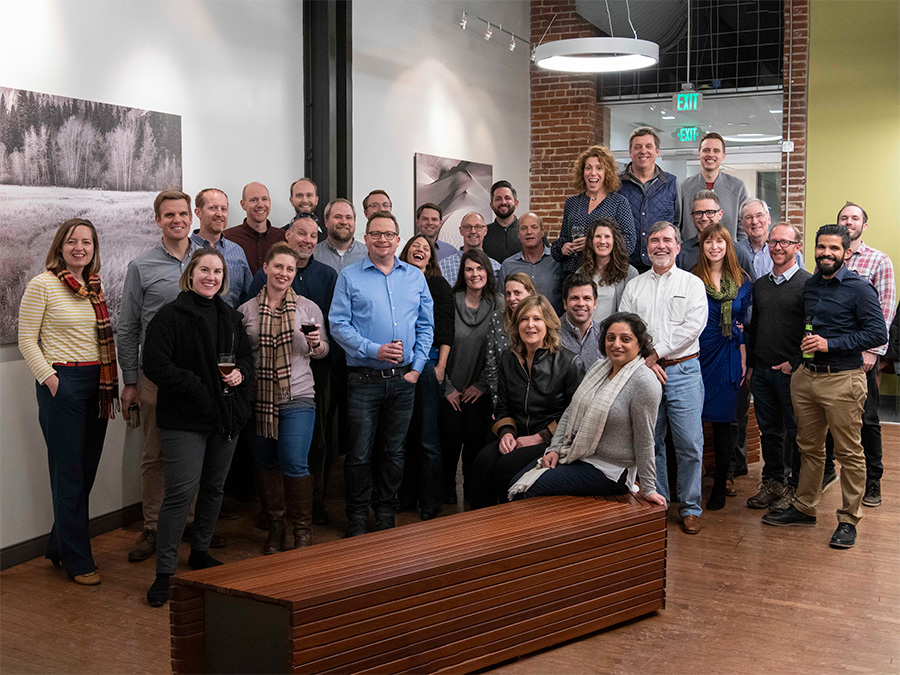News Release

Manisha, pictured here in the first row, with colleagues at a sales training in Denver.
Interview with Manisha Kaul
Posted 12/14/2020
What issue or trend is next on the horizon for our industry? Why does it matter?
Equity and the access of communities to public spaces and thereby impacts to health and wellbeing have been issues in the making for quite some time. What is different now is that these issues are debated and discussed in forums that have the ability to and an obligation to address these impactable issues; we the people. The current situation is forcing us as individuals and as professionals to seek active resolution to embedding equity in the environments that we create for people.
I also strongly believe that water and access to clean and heathy water resources, while a known issue for a while, is also going to demand similar action in the near future. While we made the right start with the Clean Water Act, we have slipped into the state of inertia and are still compartmentalizing water resources. We have not completely accepted water as a holistic resource. The well-known saying “water knows no boundaries” is still true and our actions to restore, reuse and regenerate the resource for a healthy environment also needs multi-jurisdictional agencies to come together.
As climate extremes become a frequent occurrence, the reality of old and failing infrastructure will need to be re-thought holistically. While green infrastructure is a step in the right direction, it is just that; a step. I believe that the vagaries of climate resulting in erratic flooding in areas and droughts in the others are going to challenge us to create new and better ways to realize regenerative environments. We know what the right thing is, we now need to focus on how to get it done. I think it matters because it is our obligation to the future generations – to pass on environments that not just heal the human spirit, but ones that inspires them to continue the Legacy.
What is the greatest challenge facing landscape architects today?
While we have done well in acknowledging inequity in access to public space, landscape architecture has not done enough to encourage the same diversity in our profession. How can we be effective harbingers of change when we have not focused on assimilating that change within our own ranks? A lot of what we do lies on the ecotone of multitude of professions, and it is so important to communicate that we are always willing and able to be part of teams and bring a perspective that can bring together a lot of different specialties. Our varied educational backgrounds make our individual perspectives important and the results that much more effective. It all starts with getting involved in our communities to communicate this message of change and inspire youth to be interested in pursuing careers that benefit their environment and hence by association their communities.
What is the most important design element that makes for a successful community?
A successful community is made up of healthy people with relationships with their neighbors that thrive economically, contribute to artistic endeavors and respect and nurture their environment. The community living rooms – its open space networks – contribute greatly to the health, wealth and success of its communities. There is a great body of research that links our environment, constructed and natural, to the success of communities. Our goal should be to try and create a microcosm of a successful community within each of our projects, no matter the size. When we prioritize, environment, community, art and environment, we are laying the foundation of a future successful community.
What is your favorite iconic space? Why?
Having grown up in India, my education in architecture focused my awareness on built spaces in the ancient architecture of temples and historic structures. One that stands out to me is Jain temple at Ranakpur in India. The builders achieved a perfect balance of scale and symmetry, play of light and shadows and the endless attention to detail carvings. Some of the most memorable spaces shaped by landscape architecture are from growing up in the valley of Kashmir (India) and visiting Mughal Gardens. Not only do they imbibe all the principles of Persian Garden Design, but are successful public spaces. Having lived and experienced public spaces in the United States for the last twenty years, I have found the Mall in Washington DC as one such iconic space, that reminds me time and again how the principles of good urban planning result in successful pedestrian spaces – ones that are loved immensely by people.